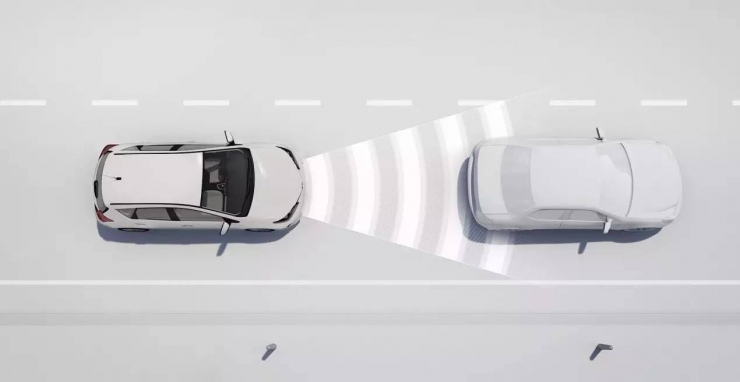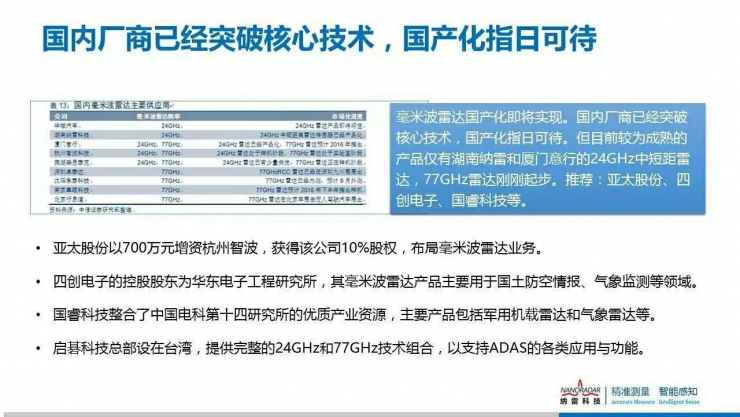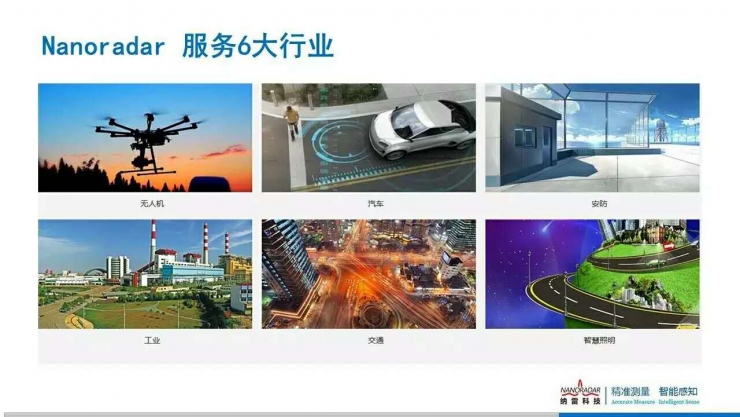
New intellectual driving (micro-signal: AI-Drive) Press: The content of this article is compiled from the " Car Innovation Harbor Micro-Lecture" (with deletion).
Zhou Kunming, former senior marketing manager of Huawei's IT product line. In April 2016, he was responsible for the overall operation of Naray Technology Co., Ltd. and led NARI Technology for 3 months to complete the strategy formulation and market layout. In the automotive sector, the millimeter-wave radar has created a 1+4 scheme, which is called a new batch in the civil radar community. "Dark horse." The following content comes from his sharing.
At present, mainstream automobile adopts millimeter wave radar sensors from abroad, and research on autonomous control is imminent. At present, the status quo in China, domestic slightly higher-end cars use millimeter-wave radar, especially such as Red Flag, Geely, etc. are all using this type of radar, including 24G radar is also used by many manufacturers.
The radar is currently under the control of overseas giants. Shipments of the mainland, Bosch, Hella, and Hella 24G are estimated to exceed 6 million, and shipments are relatively large. Domestically, China has not yet included the entire global radar statistical category, but it has started relatively quickly in these two years, and the statistics of each radar manufacturer will not be less than 20.
Why do millimeter wave radar?Millimeter-wave radar is an indispensable key component in smart cars. The main characteristics of millimeter wave can penetrate the ability of smoke, dust, has a small size, high degree of integration, sensitive and other characteristics. The second feature is that it can be applied all-weather, all-day, which is not available in other sensors. For example, millimeter-wave radar is a very good choice in rainy and snowy weather.
When overseas radars are purchased, many of them are packaged and sold together. The separate cost is low and the overall purchase cost is relatively high. From a technical point of view, it is mainly held in foreign hands.

At present, some domestic manufacturers, such as China Space, Xiamen Express, etc., have started to launch related equipment and related products. In particular, the Xiamen Chips focused on the chip design and achieved great success on 24G.
We are relatively early in the domestic market. In particular, 24G radars have already been supplied in batches. The Nare’s target market is mainly in several major areas, including drone applications, automotive applications, and security and other fields. application. Naray Technology has nearly four years of development history, and has taken many detours in the process of exploration. However, it is relatively backward before the radar, especially in the antenna, which has launched nearly 20 video antennas in the market. Sales.
With the development of radar, the domestic radar is the next outlet, and some investments can be foreseen. Judging from the current distribution of radar, it is often distributed in places where universities and research institutes are concentrated. Local core technologies such as Shenzhen are relatively few and have less distribution. The main reason is that radar is a basic research, and the exploration cycle is long and it takes a long time to accumulate.
Comparison of 24G and 77G millimeter wave radar
24G and 77G are currently the focus of relative research. The 24G is mainly used in rear applications for cars and is also used in front and sideways. The 77G is the main direction of the car's forward direction. It is generally matched with each other. According to 24G, 24G frequency bands are open in over 150 countries worldwide. 77G is relatively small, and the country has also accelerated its layout in the past two years. At the meeting organized by the Automobile Association last month, it was also discussing the issue of 77G frequency, and in the end it was decided whether 77, 79, 81 or the like would be discussed.
The conclusion of the national standard discussion may lead to the conclusion of the conclusion at the end of next year. During the process, it is important and difficult to guide the development of domestic sensors at the national level. At present, 77G is mainly concentrated in foreign hands, including 24G. Many technologies are also concentrated in the hands of foreigners. Domestically speaking, in addition to relying on our independent research and development, the state has also done some active guidance through the standard level. It is estimated that there will be actual actions next year, which will greatly help 77G promotion.
24G applies to BSD, LCA, backward crossing vehicle alarm, door opening assistance, rear collision warning, and forward vehicle alarm. In particular, BSD has started to install BSD on some mid- to high-end cars with a total of 145,000 or more.
When it comes to applications, the 24G Hella is still the boss's place. The 77G is mainly used in forward anti-collision, automatic cruise, and brake AEB systems. In terms of usage, it is still relatively easy to calibrate on 24G and 77G is more complicated.
From the perspective of 24G application scenario, the 24G frequency band allocation according to the relevant standards and requirements can improve road safety of domestic vehicle roads. The Ministry of Industry and Information Technology divides the 24.25 and 26.6G frequency bands into the use of short-range vehicle-mounted radar equipment to meet the electronic requirements. Equipment requirements for the radio spectrum. 77G is also discussing the development of standards in the country. The purpose is to promote the development of our country in this area. What kind of 77G standard may have to wait until next year to truly see a result.
The development of millimeter-wave radarJudging from the situation of products and standards, the current domestic industrial chain has not yet matured, and there are still many ways to go. The radar in foreign countries has gone through a history of several decades. The domestic start is nearly two years, especially in 2015 and this year. There are more manufacturers.
As a whole, the development of millimeter-wave radar mainly faces the following problems:
1, lack of talent and experience is still a great challenge. For example, rich radar systems and millimeter-wave RF design experience and capabilities are needed. Some are concentrated in the radar of research institutes and the military, and the other is in the hands of foreign manufacturers, resulting in a shortage of talent in this area.
2. The investment is relatively high. Equipment needs to be purchased from abroad, especially test equipment, as well as some production equipment. For example, a 24G production line invests at least 10 million or more, and sometimes it may be higher. The key is whether or not it can be used after it has been invested.
3, production equipment needs to be customized. When these devices are produced, they often don't have standard production equipment like standard devices. Many standards for production equipment need to be customized. The reasons for high costs are here. If the production line is complete, all costs add up to even higher tens of millions. Production equipment is trial production, testing, and calibration of mass production, including test equipment, calibration, material analysis, etc. all require related equipment. The current lack of 77G production and technology, domestic production and processing of 77G technology is relatively small, only concentrated in a few manufacturers inside. The domestic industrial chain environment needs to be improved.
4, the development cycle is relatively long. Generally, a millimeter-wave radar development cycle takes more than 12 months. It means that from the design, algorithm stabilization, and final use, there is a certain basis for doing it in 12 months. If there is no foundation, it is estimated from the beginning that the cycle will be longer. . It is also necessary to stabilize the cycle, and it may be as long as almost two years.
The project of the millimeter-wave radar sensor, from the current use situation, we are advancing the program is the mainstream of the 1 + 4 program, constitute a senior assisted driving program. The latter two detection rears, such as BSD, lane change assistance, etc., are used by radars. Why did you add two forwards? Some time ago, in Tesla's accident, Tesla had only one forward radar at the time of deployment. In this event, if there were two short-range radars forward, there were some short-range radars and Long range radars complement each other and it is possible to reduce the occurrence of such events and even avoid them.
There are two kinds in the industry to control this piece of algorithm. If the depot does not open the agreement, some domestic manufacturers are doing mechanical control; if the depot opens the agreement, the development of electric vehicles is relatively fast, and the car is directly controlled in this situation. Perhaps the future development is the direct chassis control of the vehicle, and it may be an important solution for future advanced driver assistance.
Industrial application of millimeter wave radar
In Nare's strategy, it focuses on six industries including drones, automobiles, security, industry, transportation, and smart lighting. Especially in smart lighting, with the development of the "Internet +" and "Made in China 2025" development ideas in China, especially the development of smart cities is relatively fast, we have done an experiment by installing radars on street lamps. This kind of energy-saving effect is very significant, especially in some road sections, such as the winter performance can be reduced by 53%, in fact, for some applications may have returned to the two years, and now some cities in the country have begun to layout.
In the area of ​​transportation, this piece is relatively mature, like measuring flow rate and speed in foreign countries, especially the bayonet. There are also some domestic companies in this sector to do it. At present, there is a certain amount of domestic accumulation.
In industrial applications may be more extensive, such as replacement of previous infrared sensors, including level gauges, robots in the industrial field, and application of industrial robots, Naray has had more cases. It is mainly used under all weather conditions. The entire radar is concerned that the domestic market is very large, but it takes a long time to accumulate.
Special emphasis will be given to the SP25, SP25, a low-power sensor with a maximum range of 30 meters. It is a single shot and one shot. This product is very good, can be used in smart sensors such as city lighting, and To drones, robots, vehicles. Specifically speaking about the vehicle, because the cost is relatively low, our goal is to replace the existing high-end ultrasonic radar. We all know that the current range of the ultrasonic radar is usually 5 meters, and the distance of a bit more than 10 meters is remarkable. In this radar can reach 30 meters, so SP25 has a huge market in this area.
Millimeter-wave radar R&D investmentThere is a problem with millimeter-wave radar. Is this cost high? --very high.
First of all, we look at the microwave-equipped darkroom, which is equipped with basic facilities. Although it is not used at present, it is still indispensable for equipment, ranging from a few million to tens of millions and tens of millions of inputs. Why is there a lot of companies in the country doing this, but they haven't done much? This is one of the reasons.
There are other relatively small instruments such as test rails and reflectors. For example, vector analyzers, spectrum analyzers, signal generators, high-speed oscilloscopes, and the like should be relatively large investments, let alone production lines.
Therefore, in the development of millimeter-wave radar, we still hope that all parties unite to jointly develop the market.

Stainless Steel Tube Processing
Stainless Steel Tube Processing,Medical Stainless Steel Tube Processing,High Precision Stainless Steel Tube Processing
ShenZhen Haofa Metal Precision Parts Technology Co., Ltd. , https://www.haofametal.com
